12 Best Customer Experience Measurement Tools for 2025
Explore our curated list of the top customer experience measurement tools for 2025. Compare features, pricing, and use cases to find the perfect solution.
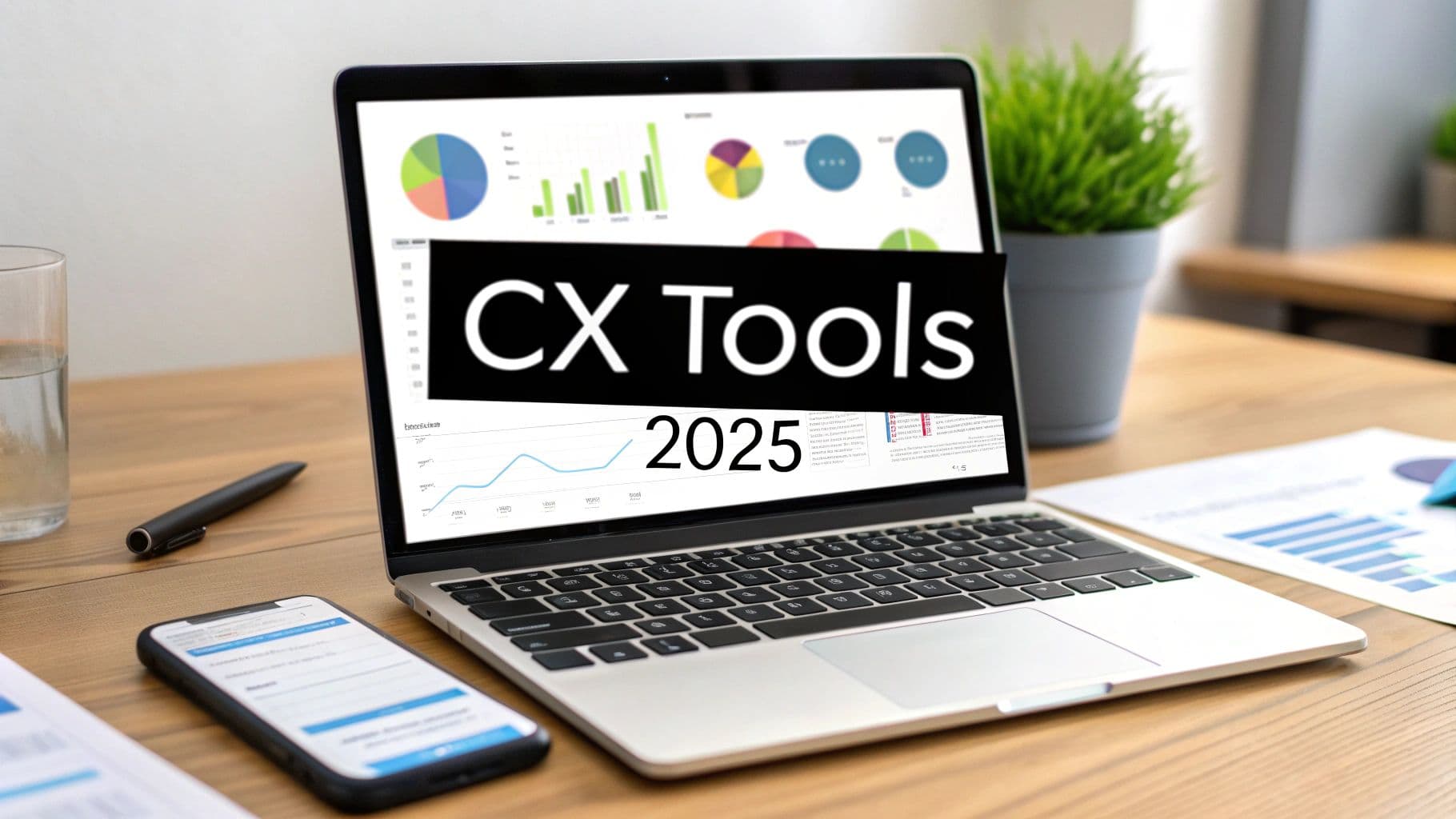
In today's competitive landscape, understanding and improving the customer journey is no longer a luxury-it's essential for survival and growth. But how do you move from subjective feedback to actionable, data-driven insights? The answer lies in using the right customer experience measurement tools. These platforms help you capture, analyze, and act on customer feedback at scale, transforming raw data into a clear roadmap for product development, service improvements, and revenue growth.
This guide breaks down 12 of the leading solutions available today. We move beyond generic feature lists to provide a practical, in-depth analysis of each tool, complete with screenshots, direct links, and honest assessments of their pros and cons. Whether you're a product manager at a fast-growing SaaS company, a customer success leader building a Voice of the Customer (VoC) program, or a CTO seeking AI-driven insights, this resource is designed to help you make an informed decision. We’ll explore everything from enterprise-grade platforms like Qualtrics and Medallia to more agile, in-product feedback tools like Sprig and Hotjar. Our goal is to equip you with the knowledge to select the best platform to measure and enhance every touchpoint of your customer journey.
1. SigOS
SigOS stands out as a premier AI-driven product intelligence platform, making it one of the most powerful customer experience measurement tools for SaaS companies. It excels at translating vast amounts of qualitative and quantitative customer feedback into actionable, revenue-centric insights. The platform continuously analyzes support tickets, chat logs, sales calls, and usage data to pinpoint specific issues causing churn and identify feature requests with the highest growth potential.
This tool is uniquely engineered to move teams beyond guesswork. Instead of manually sifting through feedback, product managers receive daily dashboards that quantify the dollar value of customer pain points. This allows for data-backed prioritization, ensuring development resources are allocated to fixes and features that will deliver the most significant business impact. Its ability to correlate feedback patterns to revenue with 87% accuracy is a significant differentiator.
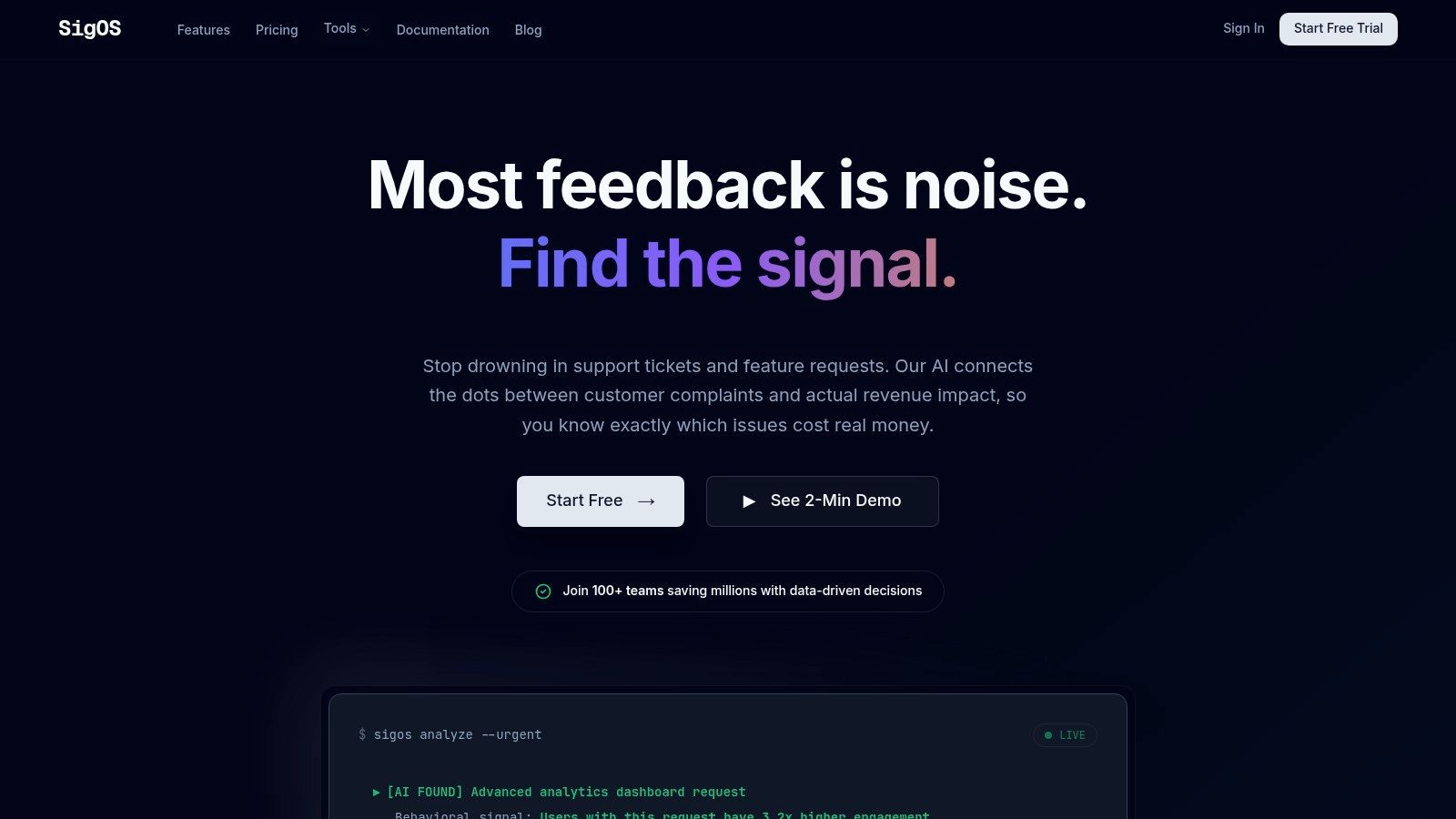
Key Features & Use Cases
SigOS offers a robust feature set designed for immediate action and strategic planning.
- Revenue Impact Analysis: Automatically calculates the monetary cost of bugs and the potential revenue gain from new features, enabling precise roadmap prioritization.
- Automated Issue Creation: Integrates directly with tools like Zendesk, Intercom, Jira, and Linear. It automatically creates tickets and issues prioritized by revenue impact, streamlining the workflow from feedback to development.
- Real-Time Churn & Growth Alerts: Proactively notifies teams of emerging patterns that signal increased churn risk or high-value expansion opportunities, allowing for timely intervention.
Use Case: A SaaS product team can use SigOS to analyze thousands of Intercom chats and Zendesk tickets. The platform might identify a recurring bug in the billing module that is directly linked to a 5% increase in churn among enterprise customers, quantifying the lost revenue at $50,000 per month. An urgent, high-priority Jira ticket is automatically created for the engineering team, complete with relevant customer quotes and data. You can explore a deeper comparison of similar platforms in this guide to customer feedback analysis tools.
Pricing and Access
Pricing for SigOS is customized based on data volume and integration needs, with details available upon direct request. They offer a free analysis trial to demonstrate the platform's value with your own data.
| Pros | Cons |
|---|---|
| Quantifies feedback with revenue impact | Pricing is not publicly listed |
| Seamless integrations with key SaaS tools | Requires initial setup to connect data sources |
| Delivers rapid, sub-minute insights | |
| High-level data privacy and security |
Website: https://sigos.io
2. Qualtrics (CustomerXM)
Qualtrics CustomerXM is a full-stack experience management platform designed for large and mid-market organizations needing to measure and act on customer feedback across every channel. It's more than just a survey tool; it's an enterprise-grade system for unifying customer, employee, and product experience data into a single, actionable view. This platform excels at handling complex, multi-touchpoint customer journeys.

Its key differentiator is its powerful AI engine, which provides deep sentiment, text, and predictive analytics. For instance, a SaaS company can use Qualtrics to automatically analyze support tickets, survey responses, and online reviews to identify emerging product issues before they escalate, then trigger automated "close the loop" workflows to alert product and support teams.
Key Details & Considerations
- Best For: Organizations requiring deep analytical capabilities and automated, role-based action plans for complex CX programs.
- Pricing: Custom. Public pricing is not available, and purchase is typically a sales-assisted process tailored to specific organizational needs.
- Pros: Scales exceptionally well for enterprise needs and provides powerful, AI-driven text and predictive analytics.
- Cons: The platform can be overkill and too complex for small businesses with simple survey-only requirements.
- Website: https://www.qualtrics.com/pricing/
3. Medallia Experience Cloud
Medallia Experience Cloud is an enterprise-grade Voice of the Customer (VoC) and CX management platform built for large organizations to capture and analyze experience signals across all channels. It centralizes feedback from surveys, social media, speech, and digital interactions into a unified system. The platform is one of the most powerful customer experience measurement tools for operationalizing feedback through sophisticated closed-loop case management and alerting.
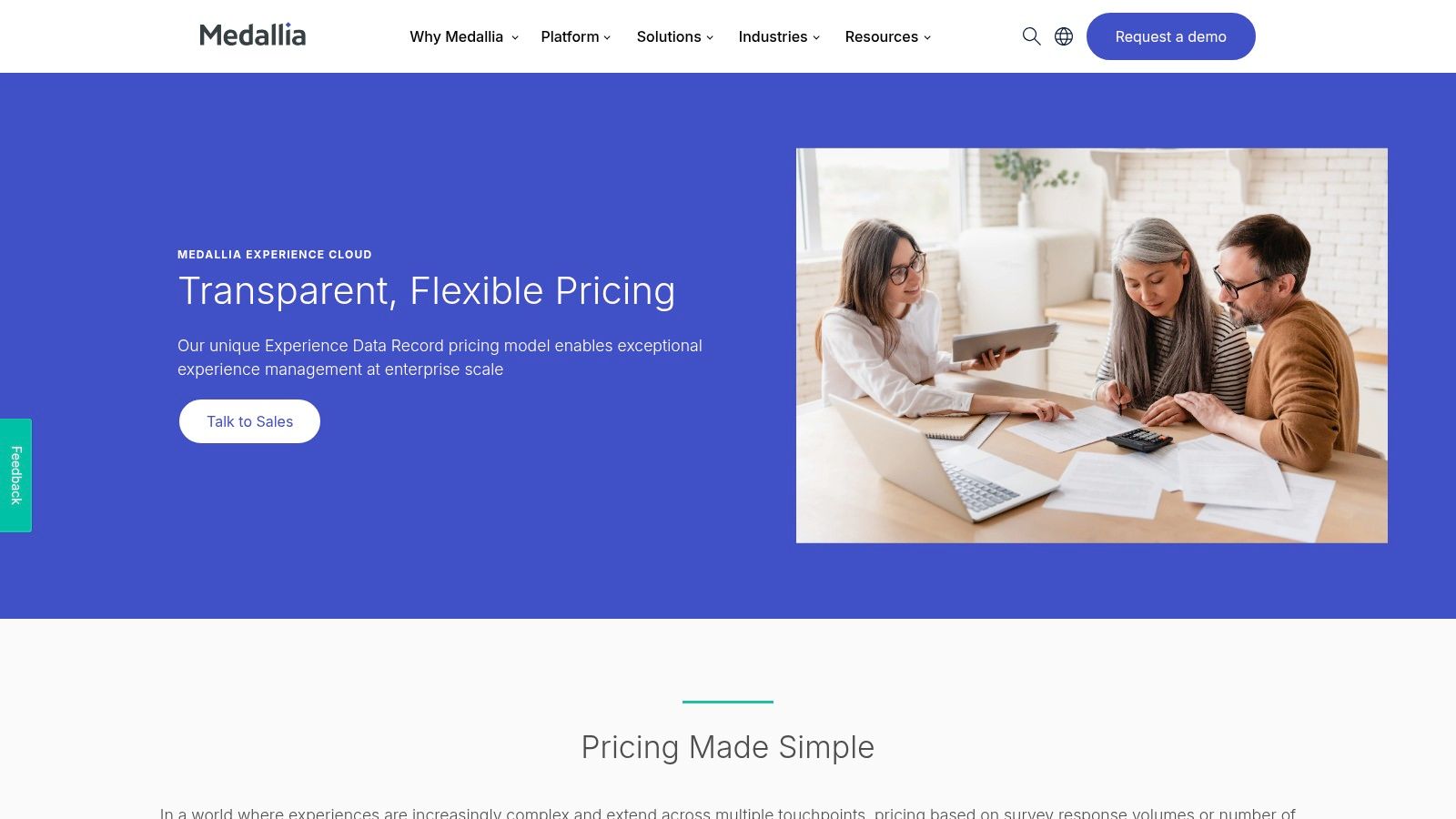
Its key differentiator is a pricing model based on Experience Data Records (EDR), not per-user seats or responses. This encourages organizations to collect a wide range of signals without facing prohibitive costs. For example, a global retailer can use Medallia to analyze in-store feedback, contact center call recordings, and website behavior simultaneously, triggering real-time alerts to store managers for immediate service recovery without worrying about individual data point costs.
Key Details & Considerations
- Best For: Enterprise and mid-market companies needing a holistic VoC program with strong governance, security, and closed-loop actioning capabilities.
- Pricing: Custom. Medallia does not offer public pricing or self-serve options; pricing is tailored through a direct sales engagement.
- Pros: The EDR pricing model provides predictable costs and encourages broad data collection. It features robust enterprise-level administrative controls and security.
- Cons: Not suitable for small businesses due to its complexity and the requirement for a vendor-led implementation process.
- Website: https://www.medallia.com/pricing/
4. SurveyMonkey (Enterprise and CX)
SurveyMonkey is an incredibly accessible platform that has evolved far beyond simple surveys, now offering robust customer experience measurement tools tailored for both self-serve users and large enterprises. It simplifies the process of launching CX programs with pre-built templates for key metrics like Net Promoter Score (NPS), Customer Satisfaction (CSAT), and Customer Effort Score (CES). This makes it an ideal starting point for teams looking to quickly gather and analyze feedback.
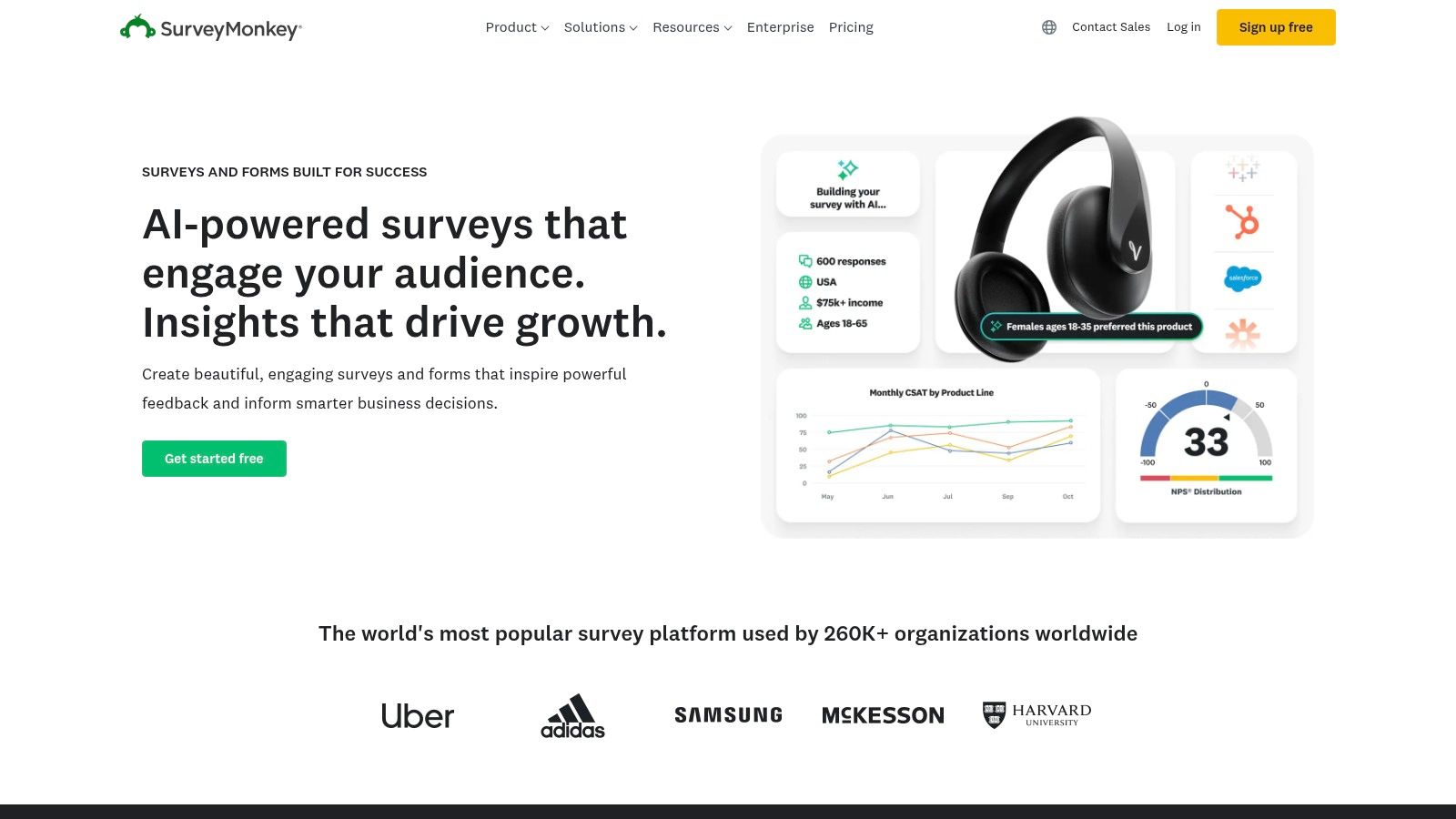
Its key differentiator is its seamless scalability and strong integration with Salesforce. A company can start with a basic plan to gauge customer sentiment after support interactions and then scale to an Enterprise plan, leveraging the updated AppExchange integration to trigger surveys automatically based on CRM data. This creates a powerful, end-to-end workflow, operationalizing feedback directly within the system where customer relationships are managed.
Key Details & Considerations
- Best For: Teams and organizations looking for a fast, user-friendly tool to launch standardized CX programs with strong Salesforce integration.
- Pricing: Offers a range of plans, from a free basic tier to custom-priced Enterprise solutions. Team Advantage is ~$25/user/month.
- Pros: Very fast time-to-value due to its intuitive interface and extensive template library. Excellent documentation and strong Salesforce ecosystem support.
- Cons: Lacks the deep, omnichannel text and predictive analytics of pure-play VoC platforms. Some advanced integrations are limited to top-tier plans.
- Website: https://www.surveymonkey.com/
5. GetFeedback by SurveyMonkey
GetFeedback is an agile customer experience (CX) platform from SurveyMonkey, designed for organizations that need to quickly deploy and manage feedback programs. It excels at capturing in-the-moment feedback using beautifully branded, mobile-first surveys for key metrics like NPS, CSAT, and CES. Its primary differentiator is its deep, native integration with Salesforce, allowing teams to trigger surveys based on CRM events and map responses directly to customer records.
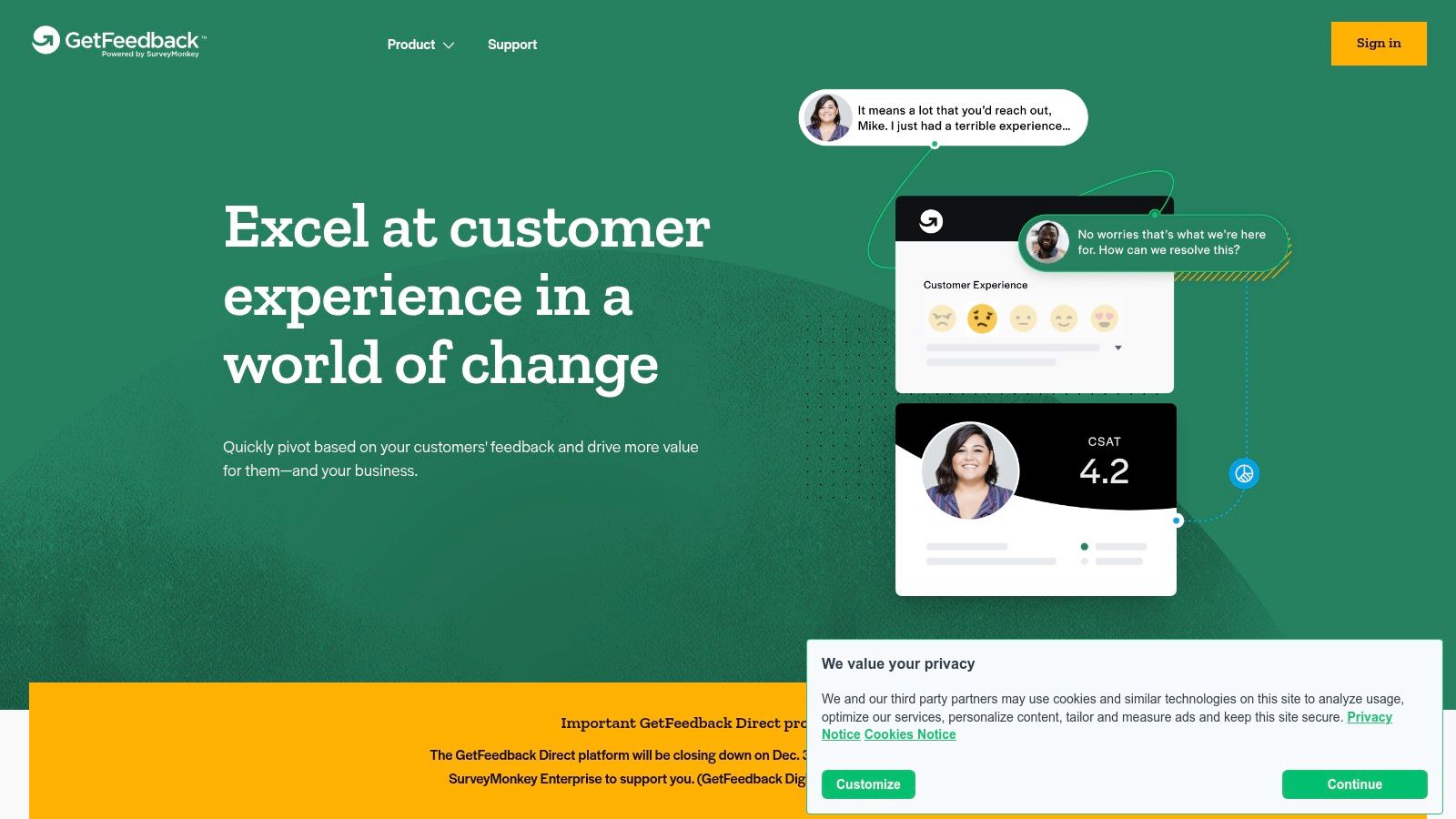
This makes it one of the most effective customer experience measurement tools for sales and support teams living in Salesforce. For example, a support team can automatically send a CSAT survey the moment a case is closed, with the score and comments instantly appearing on the contact's record. This provides immediate visibility and enables real-time service recovery workflows. This platform is ideal for leveraging different customer satisfaction measurement methods within an existing CRM ecosystem.
Key Details & Considerations
- Best For: Salesforce-centric teams needing a fast, easy-to-use platform to embed real-time CX feedback into their CRM workflows.
- Pricing: Custom pricing, requiring contact with their sales team. Plans are typically billed annually.
- Pros: Exceptional Salesforce integration and an intuitive interface make it simple to launch and scale CX programs rapidly.
- Cons: Less suitable for organizations not using Salesforce, as its main strength lies in that specific integration.
- Website: https://www.getfeedback.com/en/pricing/
6. Delighted by Qualtrics
Delighted by Qualtrics is a streamlined, self-serve customer experience measurement tool designed for speed and simplicity. It focuses on core metrics like NPS, CSAT, and CES, making it exceptionally easy for small to medium-sized businesses to launch feedback programs without extensive setup. Its strength lies in its user-friendly interface and transparent, accessible pricing, which allows teams to gather actionable insights quickly.
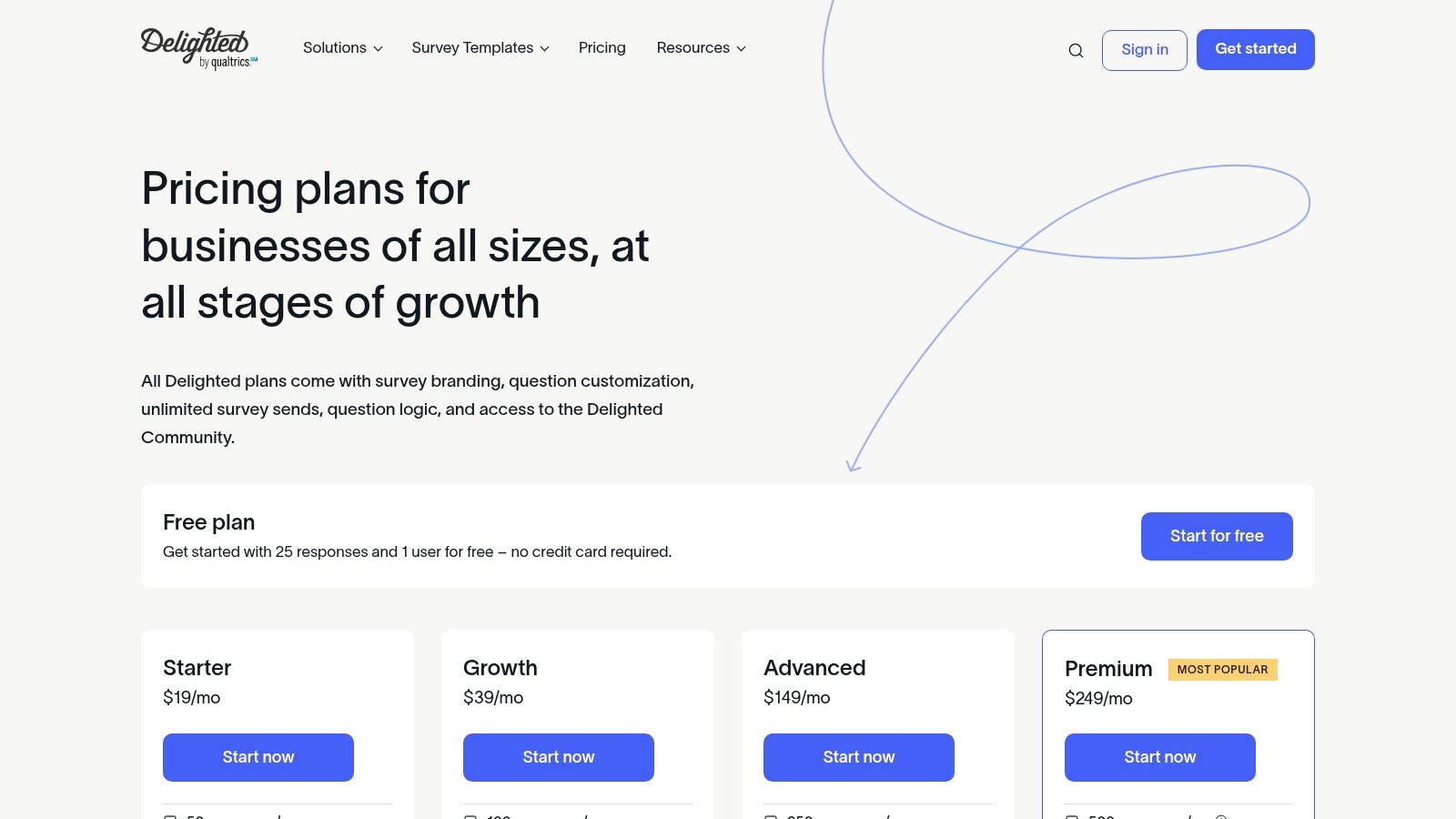
The platform is ideal for a startup wanting to quickly implement a Net Promoter Score program. They can sign up for the free tier, send surveys via email or a website link, and start analyzing feedback within minutes. As needs grow, Delighted offers features like survey logic and multi-language support, providing a clear upgrade path without overwhelming complexity. It serves as an excellent entry point into the world of customer feedback.
Key Details & Considerations
- Best For: SMBs and teams needing a fast, simple, and affordable way to start collecting and acting on core CX metrics.
- Pricing: Offers a generous free plan. Paid plans start at $17/month (billed annually), with transparent pricing based on response volume.
- Pros: Extremely fast setup with a very intuitive interface and straightforward pricing. It’s a great stepping stone to the more powerful Qualtrics ecosystem.
- Cons: The product is scheduled to be sunset by June 30, 2026, with renewals ending after June 30, 2025, making it unsuitable for long-term planning. It is less powerful for complex, multi-source Voice of the Customer (VoC) programs.
- Website: https://delighted.com/pricing
7. NICE CXone Feedback Management (NICE Satmetrix)
Originating from Satmetrix, the co-creator of the Net Promoter Score (NPS), NICE CXone Feedback Management is a specialized tool integrated into the broader NICE CXone contact center platform. It is designed to capture omnichannel customer feedback, particularly excelling in voice and post-interaction contexts. This platform is more than just a survey tool; it's a contact-center-grade system for collecting and analyzing feedback from IVR, SMS, web, and email channels.
Its key differentiator is the deep integration with contact center operations and its robust support for voice feedback. For example, a telecommunications company can use the platform to automatically trigger an IVR survey immediately after a support call, capture the verbal feedback, use speech-to-text to analyze sentiment, and link the score directly to the specific agent and interaction. This provides immediate, actionable insights for agent coaching and process improvement, making it one of the premier customer experience measurement tools for voice-centric businesses.
Key Details & Considerations
- Best For: Companies with significant call center operations or existing NICE CXone users who need to integrate customer feedback directly into their service workflows.
- Pricing: Custom quote-based. Pricing and detailed documentation are not publicly available and require engaging with their sales team.
- Pros: Exceptional capability for voice and post-call feedback at scale, and includes valuable NPS benchmarks and best-practice training resources.
- Cons: Better suited for organizations already using the CXone ecosystem; standalone implementation can be complex and may be overkill for non-contact center use cases.
- Website: https://www.nice.com
8. InMoment XI Platform
InMoment’s XI Platform is an enterprise-grade experience improvement (XI) solution designed for organizations looking to unify customer, employee, product, and market experience data. It moves beyond traditional feedback collection, integrating operational and financial data to provide a holistic view of the business. The platform's strength lies in its ability to ingest data from virtually any source and use advanced analytics to surface actionable insights.
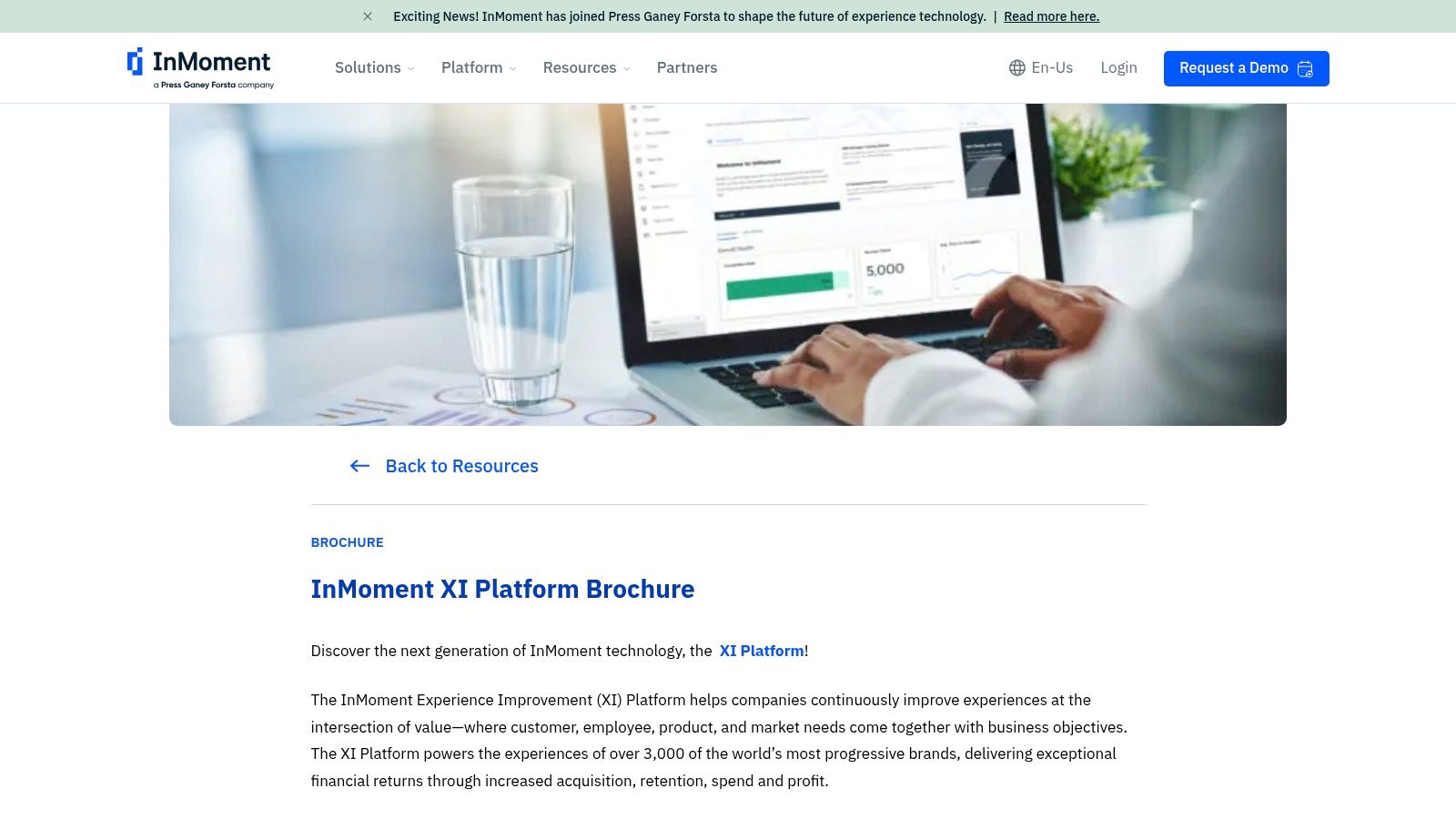
Its core differentiator is its focus on continuous improvement across all business functions, not just customer service. For example, a global retailer could use the XI Platform to correlate in-store feedback with supply chain data and employee satisfaction scores. This helps identify how operational inefficiencies in one department directly impact customer sentiment and ultimately reduce customer churn, making it a powerful tool for strategic decision-making.
Key Details & Considerations
- Best For: Mature organizations that need to integrate disparate data sources (CX, EX, operational) for a comprehensive, cross-journey improvement program.
- Pricing: Custom. Pricing is not public and requires a detailed discovery process and tailored implementation plan.
- Pros: Excellent for holistic, enterprise-wide experience programs and trusted by thousands of major brands for its robust capabilities.
- Cons: Deployment is more complex and resource-intensive than simple survey tools; it can be overkill for companies not ready for a full XI strategy.
- Website: https://inmoment.com/resource/xi-platform-brochure/
9. Hotjar (Ask: Surveys & Feedback)
Hotjar's "Ask" suite provides an accessible yet powerful way for product, UX, and marketing teams to capture in-the-moment user sentiment directly on their site or app. While known for its behavioral analytics (heatmaps and session replays), its feedback tools offer a crucial layer of attitudinal data, making it a well-rounded platform for understanding the "why" behind user actions. This combination is its key differentiator among customer experience measurement tools.
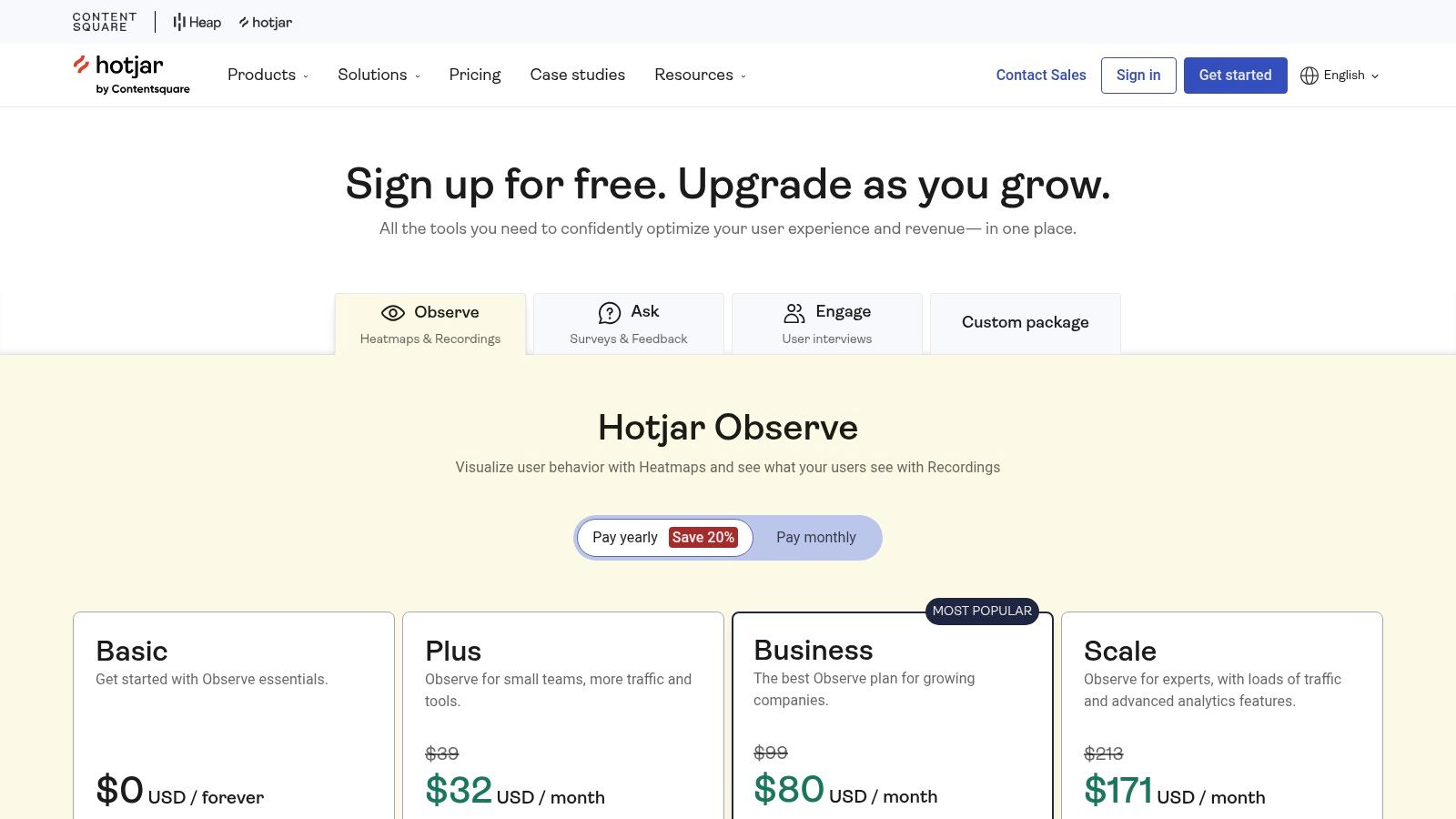
For instance, an e-commerce site can use Hotjar to trigger a survey when a user abandons their cart, asking about the reason. They can then watch session replays of those specific users to see the friction point they described, such as a confusing checkout field. The new AI-assisted survey creation and open-text summaries help teams quickly generate insights from qualitative feedback without manual analysis.
Key Details & Considerations
- Best For: Product and UX teams needing to connect qualitative user feedback directly to quantitative behavioral analytics within a single platform.
- Pricing: Offers a free tier. Paid plans start at €32/month (Observe Basic) and €48/month (Ask Basic), with scaling costs based on sessions/responses.
- Pros: Combines qualitative and quantitative data seamlessly. Offers clear, published pricing with a generous free plan for getting started.
- Cons: Not a full-scale Voice of the Customer (VoC) suite and lacks advanced case management. Response quotas on lower tiers can be restrictive.
- Website: https://www.hotjar.com/pricing-acq-1629/
10. Sprig
Sprig is an AI-powered product experience platform designed for modern product and research teams to capture in-context user insights. It specializes in delivering targeted, in-product micro-surveys and session replays at the precise moment they are most relevant, enabling teams to gather high-quality, actionable feedback directly within the user journey. The platform is built to provide rapid, qualitative insights without disrupting the user flow.
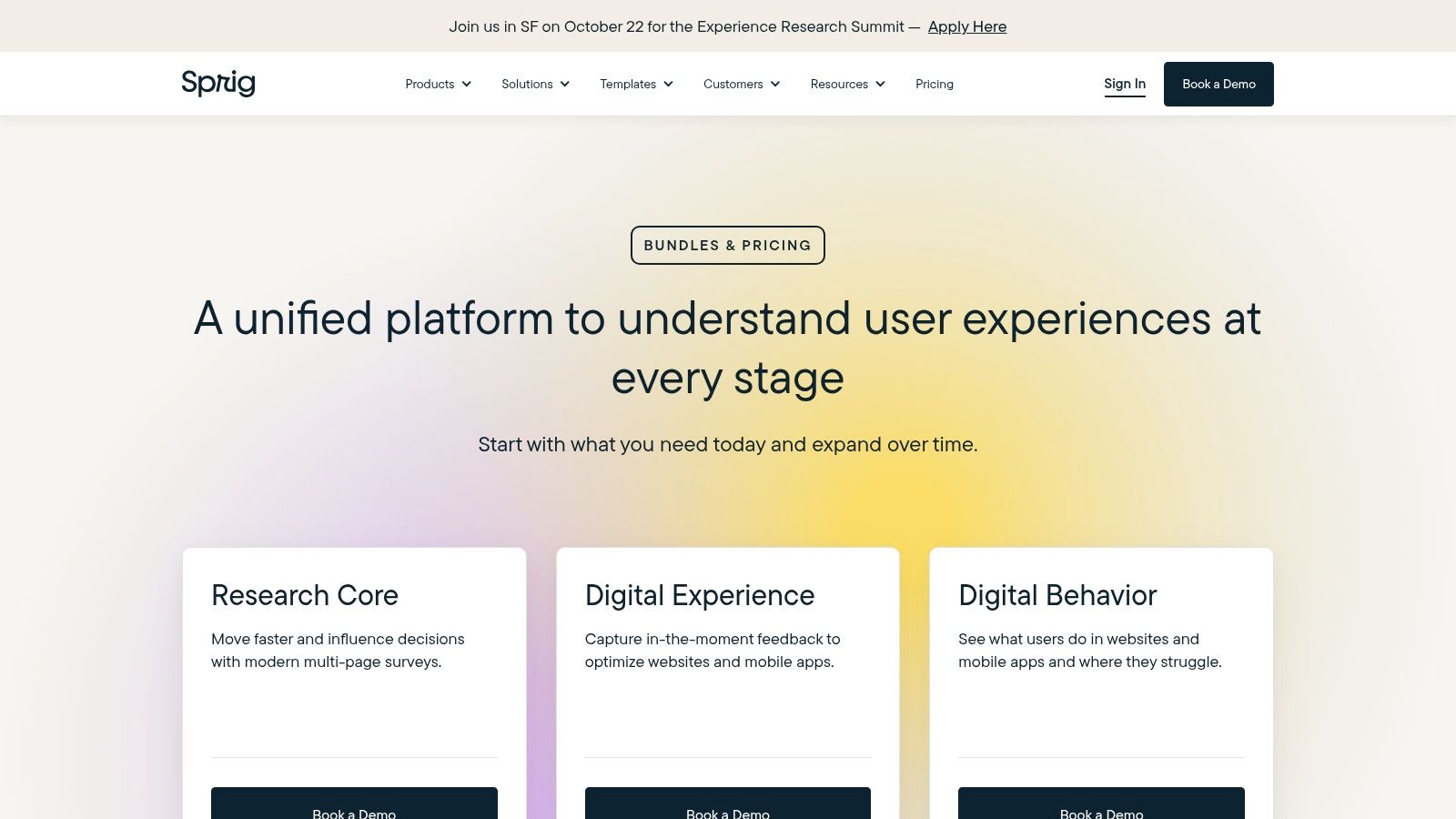
Its standout feature is its powerful AI analysis engine, which instantly synthesizes qualitative responses from surveys into a summarized, themed overview. For example, a product manager can launch a survey after a user completes a new feature onboarding. Sprig's AI will then automatically group open-text answers into key themes like "confusing UI" or "helpful tutorial," allowing the team to quickly grasp user sentiment and identify improvement areas without manually reading hundreds of responses.
Key Details & Considerations
- Best For: Product-led teams needing rapid, qualitative in-app feedback and AI-driven analysis to inform product development and user experience decisions.
- Pricing: A free plan is available. Paid tiers are custom-priced and require engagement with their sales team for a tailored quote.
- Pros: Generous free plan and incredibly fast time-to-insight with AI-powered summaries. Ideal for capturing CX signals within web and mobile apps.
- Cons: Requires a lightweight code integration to enable in-product targeting and replays. Paid tiers are custom-quoted, lacking transparent pricing.
- Website: https://sprig.com/pricing
11. Zendesk (native CSAT) + Zendesk Marketplace survey apps
For teams already embedded in the Zendesk ecosystem, leveraging its native and marketplace tools offers one of the most integrated approaches to customer experience measurement. Zendesk's platform allows you to automatically send a CSAT (Customer Satisfaction) survey the moment a support ticket is resolved. This creates a seamless, low-friction feedback loop directly tied to specific service interactions, making it incredibly powerful for support quality management.
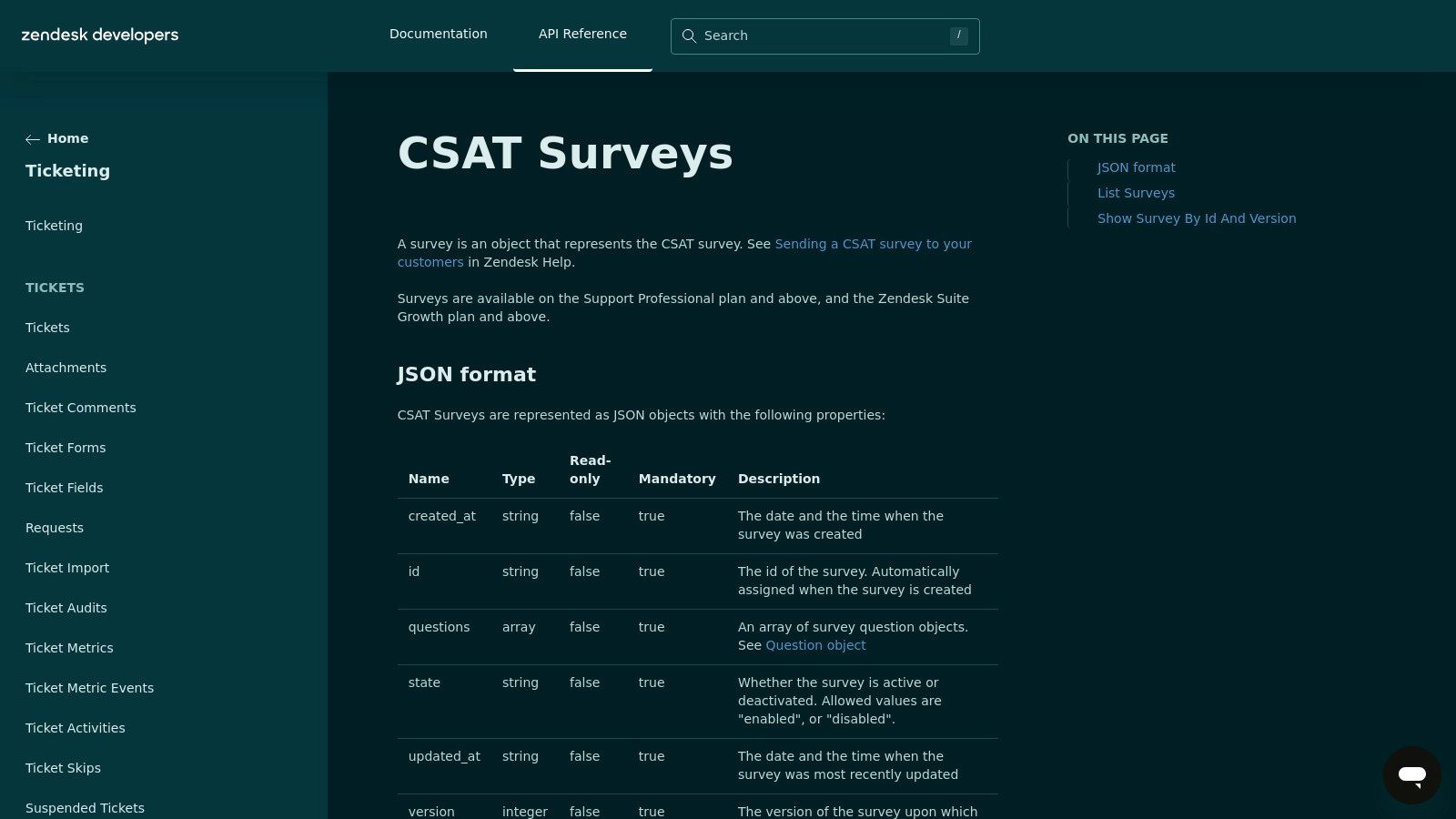
What makes this a unique option is its extensibility. While the built-in CSAT is basic, the Zendesk Marketplace provides access to powerful survey apps like SweetHawk Survey or Simplesat. A support leader can use the native CSAT for post-ticket feedback while using a marketplace app to trigger a more in-depth CES (Customer Effort Score) or NPS survey based on specific ticket tags or resolution times, all reported within Zendesk Explore or the app’s dedicated dashboard.
Key Details & Considerations
- Best For: Companies heavily invested in the Zendesk suite that want to embed CX measurement directly into their customer service workflows.
- Pricing: Native CSAT is available on most paid plans. Marketplace apps have separate, often per-agent, monthly subscriptions.
- Pros: Extremely low friction if already using Zendesk; CX data is directly tied to support tickets for clear context. Published app pricing and free trials are available.
- Cons: Native CSAT is very basic; advanced NPS/CES and survey logic require purchasing and managing additional third-party apps.
- Website: https://developer.zendesk.com/api-reference/ticketing/ticket-management/csat_surveys/
12. Salesforce AppExchange – Apps to Measure Customer Satisfaction
For businesses deeply embedded in the Salesforce ecosystem, the AppExchange offers a marketplace of curated customer experience measurement tools designed to integrate natively with their CRM. This isn't a single tool but rather a collection of vetted third-party survey, NPS, and CSAT applications. Its primary advantage is enabling teams to deploy feedback mechanisms directly within existing Salesforce workflows, eliminating data silos.
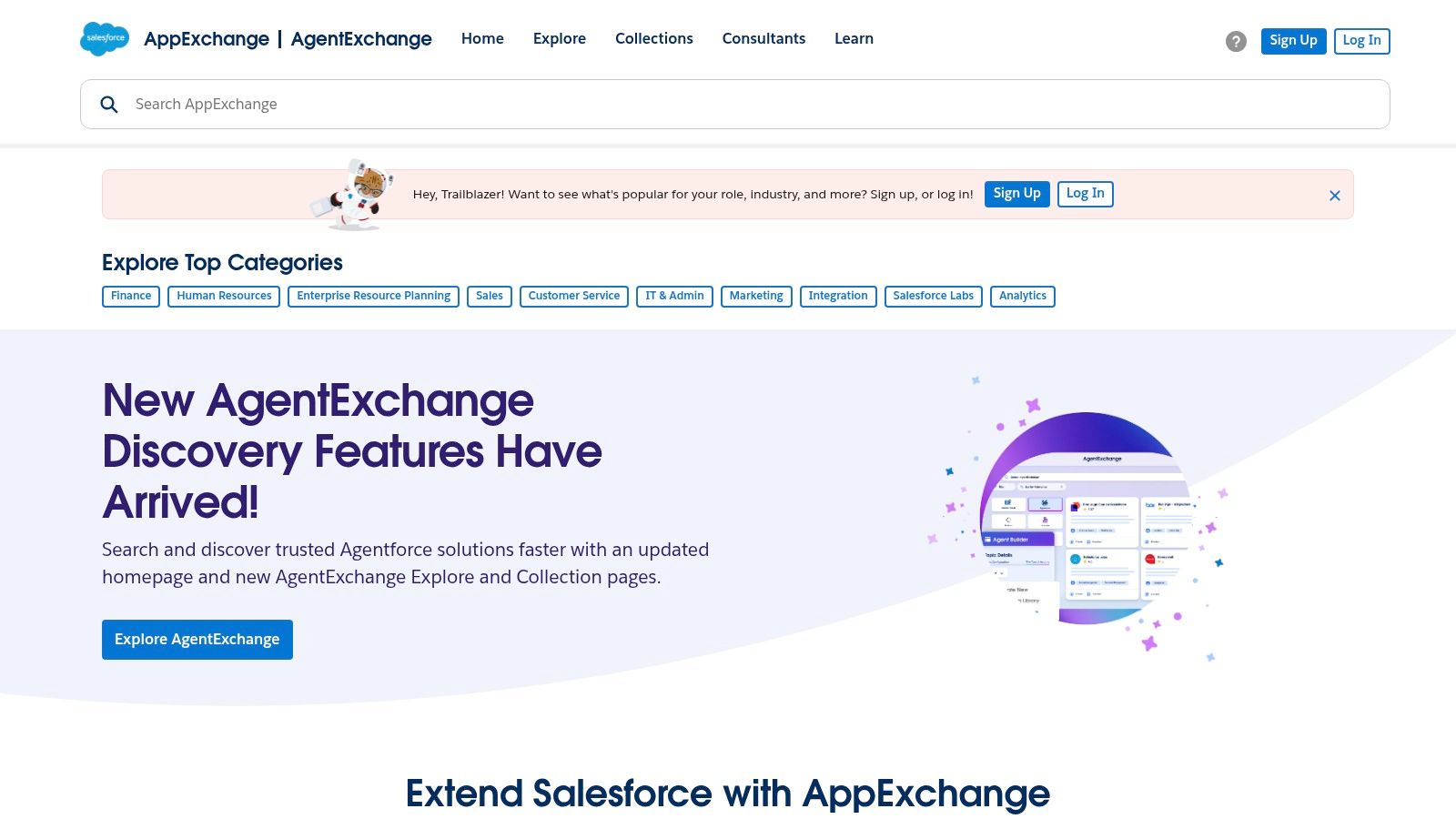
The key differentiator is seamless data integration. For example, a support team can use an AppExchange app to automatically trigger a CSAT survey after a case is closed in Service Cloud. The response data is then written directly back to the contact or account record, providing a complete, 360-degree view of customer health without manual data mapping. This direct connection makes it a powerful resource for Salesforce-centric organizations.
Key Details & Considerations
- Best For: Companies that use Salesforce as their central CRM and want to embed customer feedback data directly into their contact and account records.
- Pricing: Varies significantly by app vendor. Options range from free trials to enterprise-level subscriptions, often requiring sales engagement.
- Pros: Native integration ensures data is centralized within Salesforce, and the marketplace allows for side-by-side comparison of multiple vendors.
- Cons: Most effective only for organizations with Salesforce-centric workflows; pricing structures can be inconsistent across different apps.
- Website: https://appexchange.salesforce.com
Customer Experience Measurement Tools Comparison
| Product | Core Features / Insights | User Experience / Quality ★ | Value Proposition 💰 | Target Audience 👥 | Unique Selling Points ✨ |
|---|---|---|---|---|---|
| 🏆 SigOS | AI-driven behavioral analysis; 87% accuracy | ★★★★★ | Custom pricing; free trial | SaaS PMs, Growth, CS teams | Revenue impact quantification; real-time alerts; strong privacy 🔒 |
| Qualtrics (CustomerXM) | Full-stack XM platform with AI analytics | ★★★★ | Sales-assisted pricing | Large & mid-market enterprises | Deep AI/text analytics; enterprise governance |
| Medallia Experience Cloud | Multi-signal VoC and CX suite | ★★★★ | Quote-based pricing | Mid-market & enterprise | Broad signal ingestion; EDR pricing model |
| SurveyMonkey (Enterprise and CX) | Survey templates with Salesforce integration | ★★★ | Tiered pricing | SMB to enterprise | Fast value; Salesforce ecosystem support |
| GetFeedback by SurveyMonkey | Agile NPS/CX programs; Salesforce aligned | ★★★ | Sales-assisted | Salesforce-centric orgs | Mobile-ready surveys; real-time alerts |
| Delighted by Qualtrics | Simple NPS/CSAT tool with free tier | ★★★ | Transparent; from $17/month | SMBs and quick CX starts | Easy setup; multi-language support |
| NICE CXone Feedback Management | Omnichannel surveys (IVR, SMS) | ★★★★ | Quote-based | Contact centers & CXone users | Voice feedback scale; NPS benchmarking |
| InMoment XI Platform | Multi-cloud CX+EX+MX+PX platform | ★★★★ | Quote-based | Enterprise CX programs | Broad data ingestion; cross-journey insights |
| Hotjar (Ask: Surveys & Feedback) | Web/product surveys + behavioral analytics | ★★★ | Clear pricing; free tier available | Product & UX teams | AI survey creation; heatmaps & session replay |
| Sprig | In-product AI surveys & session replay | ★★★ | Custom pricing (sales needed) | Product-led teams | AI-generated surveys; behavior targeting |
| Zendesk (native CSAT) + Marketplace apps | CSAT surveys integrated with Zendesk support | ★★★ | Published app pricing | Zendesk users | Embedded CX in support; API & marketplace apps |
| Salesforce AppExchange (CX apps) | Curated CX apps marketplace | ★★★ | Varies by vendor | Salesforce-centric orgs | Security-vetted apps; CRM integration |
Connecting Feedback to Revenue: Your Next Steps
Navigating the landscape of customer experience measurement tools can feel overwhelming. We've explored a dozen powerful platforms, from enterprise-grade suites like Qualtrics and Medallia to specialized solutions like Sprig for in-product feedback and Hotjar for behavioral insights. The core takeaway is clear: the right tool isn't just about collecting data, it's about translating customer sentiment into strategic action that directly impacts your bottom line.
The journey from gathering CSAT scores to preventing churn and identifying expansion opportunities begins with selecting a platform that aligns with your company's specific stage and goals. A comprehensive solution like NICE CXone might be ideal for a large contact center, while a startup might gain more immediate value from the agile feedback loops provided by Delighted or GetFeedback. The key is to look beyond feature lists and focus on how a tool integrates into your existing tech stack and workflows.
How to Choose Your CX Measurement Tool
Making the right choice requires a clear-eyed assessment of your organization's needs. Don't chase the most feature-rich platform if you lack the resources to implement it fully. Instead, use this checklist to guide your decision-making process:
- Integration is Non-Negotiable: Does the tool connect seamlessly with your CRM (like Salesforce), support desk (like Zendesk), and data warehouse? Manual data transfer creates friction and siloes, defeating the purpose of a unified CX program.
- Scalability for the Future: Consider where your company will be in two years. Will your chosen tool support multiple product lines, international markets, and growing user volumes? Plan for growth from the outset.
- Actionability of Insights: A dashboard full of charts is useless without clear, actionable insights. Prioritize customer experience measurement tools that use AI to surface trends, identify at-risk customer segments, and, crucially, quantify the financial impact of CX issues and improvements.
- User Experience for Your Team: Who will be using this tool daily? Ensure the interface is intuitive for product managers, customer success teams, and leadership alike. A complex tool that no one uses is a wasted investment.
From Measurement to Mastery
Ultimately, the goal is to embed the customer's voice into every decision your company makes. The most advanced organizations don't just measure satisfaction; they use customer feedback as a predictive indicator of future revenue. They connect a poor onboarding experience directly to early-stage churn or a highly-requested feature to an expansion opportunity.
This is the new frontier of customer experience management. It's about moving from reactive problem-solving to proactive, data-driven growth strategies. Whether you start by implementing simple CSAT surveys through Zendesk or deploying an advanced AI platform like SigOS to model the revenue impact of feedback, the first step is to commit to listening. By choosing one of the customer experience measurement tools detailed in this guide, you are equipping your team to not only hear your customers but to understand them in a way that fuels sustainable growth.
Ready to move beyond simple surveys and connect customer feedback directly to revenue? SigOS uses advanced AI to analyze your qualitative feedback, quantify its financial impact, and provide a clear roadmap for prioritizing initiatives that boost retention and drive expansion. Discover how to turn your customer voice into your most powerful growth lever at SigOS.


